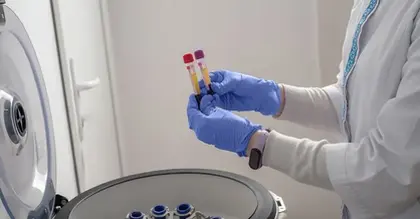
- Researchers estimate that the average person consumes between 78,000 and 211,000 microplastic particles every year.
- Past studies show that microplastics and nanoplastics can be harmful to human health.
- A new study has found that humans tend to have higher concentrations of microplastics in the brain compared to other bodily organs.
- Researchers also found that people diagnosed with dementia have up to 10 times more microplastics present in their brains than those without the condition.
Past studies show that microplastics — extremely small pieces of plastic that are either manufactured or a byproduct of the breakdown of larger plastic items — are not only harmful to the environment, but also to
Researchers estimate that the average person consumes between 78,000 and 211,000 microplastic particles every year through drinking water, foods contaminated by microplastics, and breathing microplastics-containing air.
Through previous research, microplastics have been linked to an increased risk for several health conditions such as heart disease,
“Environmental concentrations of micro- and nanoplastics (MNPs) have been increasing exponentially over the past half-century,” Matthew Campen, PhD, toxicologist and Distinguished Professor in the College of Pharmacy at the University of New Mexico, explained to Medical News Today.
“Despite this rapid rise, much remains to be uncovered about how MNPs may pose potential risks to human health. Ongoing research is essential to clarify these risks, helping us stay ahead of the curve in understanding their effects and enabling us to develop strategies to prevent or mitigate possible harm,” he added.
Campen is the lead author of a new study recently published in the journal
Researchers also found that people diagnosed with dementia have up to 10 times more microplastics present in their brains than those without the condition.
For this study, researchers analyzed post-mortem brain tissue samples donated by the New Mexico Office of the Medical Investigator from between the years 2016 and 2024.
“This project was designed to specifically study concentrations of microplastics in human brains because it is one of the most critical tissues for understanding potential health risks,” Marcus Garcia, PharmD, toxicologist and PhRMA Foundation Fellow in the College of Pharmacy at the University of New Mexico, and co-first author of this study, told MNT. “Investigating microplastics in the brain can help determine whether these particles pose a direct threat to neurological health.”
“Additionally, with concern that microplastics accumulate in the brain over time, and since the brain has limited clearance mechanisms, this raises important questions that require more in-depth research to fully understand the potential long-term effects,” Garcia added.
Using a special method devised by the scientists, they identified the presence of 12 different polymers in the brain tissue samples, with
Upon analysis of the study’s findings, researchers found that concentrations of microplastics were much greater in the brain than other areas of the body, including the liver, kidneys,
“The finding that microplastic concentrations in the brain are higher than in the liver and kidney and even higher than previous reports for placentas and testes is significant for several reasons,” Campen said.
“First, it suggests that the brain may be uniquely vulnerable to micro- and nanoplastic accumulation, likely due to its high metabolism and lipid-rich composition. Secondly, while this finding highlights the pervasive nature of microplastic exposure, it also offers a reason for optimism.”
– Matthew Campen, PhD
“In this study, we showed an absence of higher concentrations in older individuals, [which] suggests that the human body may be able to eliminate or excrete these particles over time,” he continued. “This reinforces the importance of effective environmental policies, as reducing exposure could directly impact microplastic accumulation in the body.”
“Furthermore, our data provide insights into the potential origins of these microplastics, likely from decades-old degraded materials, helping shape targeted environmental strategies for the future,” Campen added.
The scientists also found that brain tissue samples from people who had been diagnosed with dementia included up to 10 times more microplastics than those who did not have the disease.
“The finding that brain tissue from individuals diagnosed with dementia had up to 10 times as much plastic as those without the condition is significant, but it’s important to interpret this cautiously,” Garcia said.
“While the concentrations of microplastics appear higher in dementia specimens, we do not currently suggest that microplastics cause dementia. It’s possible that the disease itself could influence microplastic accumulation, perhaps due to changes in brain metabolism, altered clearance mechanisms, or other disease-related factors,” he explained.
“This observation highlights the need for further research to understand the relationship between microplastics and neurological conditions, but at this stage, it’s too early to draw conclusions about causation,” added the researcher.
MNT also spoke with Jasmin Dao, MD, PhD, a pediatric and adult neurologist at Miller Children’s & Women’s Hospital Long Beach and MemorialCare Long Beach Medical Center in California about this study.
“The environmental exposure of microplastic and nanoplastic has significantly increased over the years,” Dao, who was not involved in this research, commented.
“The effects and extent of how this affects our body is still being elucidated. It is alarming to learn that microplastic and nanoplastic concentrations in brain samples were found to have seven to 30 times more than concentrations seen in kidneys and liver, but more studies need to be done to understand what the health implications are. This study calls attention to the fact that MNP levels are increasing and making their way into our body at rising rates,” she noted.
MNT also spoke with Kamal Wagle MD, MPH, associate professor of clinical medicine at Hackensack Meridian school of Medicine and attending physician in the Center for Memory Loss and Brain Health in the Neuroscience Center at Hackensack Meridian Health in New Jersey, about this research.
He told us that:
“We know that cerebrovascular walls and immune cells play key roles in pathology of several neurological disorders that lead to memory decline and the study showed that there is high concentration of micro- and nanoplastics (MNP) in the same area. We need more clarity on pathology of how MNPs make their way to the brain tissues and what are the processes and how it might lead to more nerve degeneration.”
MNT asked both Dao and Wagle for tips on how readers can possibly protect their bodies and brains from microplastics.
They advised applying a number of strategies, including:
- cutting back on plastic use when possible, for example, by using reusable containers
- being mindful of single-use plastic and not using it over and over
- avoiding heating plastic food packaging, as plastic particles can spread into the food
- focusing on good sources for our food — making sure our seafood is from sources that have less microplastics, for example
- avoid foods that are ultra-processed, as there have been some
reports of MNPs in ultra-processed food - avoiding bottled water, as this can be a common source of microplastics; drinking filtered tap water instead could help avoid exposure
- wearing natural fiber clothing — organic cotton or hemp — and avoiding those with synthetic fibers
- vacuuming our homes more often, as microplastics can accumulate in household dust
- being careful of environmental pollutants as high air pollution areas might have more MNPs in air
- making sure our environment at home or work has a good air ventilation system.





